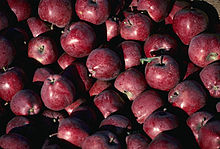Red Delicious
Táo 'Red Delicious' là một loại táo rất phổ biến, được công nhận lần đầu tiên ở Madison, Iowa vào năm 1872, ngày nay có hơn 50 giống được trồng. Từ năm 1968 đến năm 2018, nó là giống được sản xuất nhiều nhất ở Mỹ.[1][2][3]
| Malus 'Red Delicious' | |
|---|---|
 | |
| Loài | Malus domestica |
| Nguồn gốc lai ghép | Hạt giống nhân tạo không chủ ý |
| Giống cây trồng | 'Red Delicious' |
| Nguồn gốc xuất xứ | Peru, Iowa, Hoa Kỳ |


Lịch sử
sửa'Red Delicious' có nguồn gốc tại một vườn cây ăn quả vào năm 1872 được biết đến là "một loại trái cây tròn, màu vàng đỏ có vị ngọt vượt trội".[4][5] Stark Nurseries tổ chức một cuộc thi vào năm 1892[6] để tìm một giống táo thay thế cho táo 'Black Ben Davis'. Giống chiến thắng là một giống táo sọc đỏ và vàng được gửi đến tham dự bởi Jesse Hiatt, một nông dân ở Peru, Iowa, ông đã gọi nó là "Hawkeye". Stark Nurseries đã mua bản quyền từ Hiatt, đổi tên giống thành "Stark Delicious", và bắt đầu nhân giống nó. Một giống táo khác, sau này được đặt tên là 'Golden Delicious', cũng được đưa ra thị trường bởi Stark Nurseries sau khi nó được mua từ một người nông dân ở Quận Clay, West Virginia,[7] vào năm 1914; 'Delicious' là từ viết tắt của 'Red Delicious'.[8]
Tham khảo
sửa- ^ “2018 Annual Review” (PDF). U.S. Apple Association. Bản gốc (PDF) lưu trữ ngày 24 tháng 1 năm 2019. Truy cập ngày 25 tháng 11 năm 2021.
- ^ “Red Delicious Apples Weren't Always the Worst”. New England Today (bằng tiếng Anh). 24 tháng 9 năm 2019. Truy cập ngày 11 tháng 5 năm 2021.
- ^ “Apple varieties”. US Apple Association. Truy cập ngày 11 tháng 5 năm 2021.
- ^ Susan Dolan (2009). Fruitful Legacy: A Historic Context of Orchards in the United States, with Technical Information for Registering Orchards in the National Register of Historic Places. National Park Service, Olmsted Center for Landscape Preservation, Pacific West Regional Office, Cultural Resources, Park Historic Structures and Cultural Landscapes Program. tr. 76. ISBN 978-0-16-082127-1.
- ^ Higgins, Adrian (5 tháng 8 năm 2005). “Why the Red Delicious No Longer Is”. The Washington Post. Lưu trữ bản gốc ngày 29 tháng 8 năm 2021. Truy cập ngày 25 tháng 11 năm 2021.
- ^ Leona (Lee) Novy Jackson. “Archived copy” (PDF). "Delicious Apples and Their History". Bản gốc (PDF) lưu trữ ngày 13 tháng 7 năm 2011. Truy cập ngày 25 tháng 11 năm 2021.Quản lý CS1: bản lưu trữ là tiêu đề (liên kết), Apples, Apples Everywhere—Favorite Recipes From America's Orchards. ISBN 0-930643-11-9. Images Unlimited Publishing. Maryville, MO.
- ^
Mulcaster, Glenn (3 tháng 11 năm 2009). “History of a Golden Opportunity”. THE AGE Epicure. Truy cập ngày 25 tháng 11 năm 2021.
The myth-making in US horticulture that consigned Johnny Appleseed to caricature has coloured the background of the 20th century's most enduring apple.
- ^ Higgins, Adrian (5 tháng 8 năm 2005). “Why the Red Delicious No Longer Is. Decades of Makeovers Alter Apple to Its Core”. The Washington Post. Truy cập ngày 25 tháng 11 năm 2021.
The reliance on Red Delicious helped push Washington's apple industry to the edge in the late 1990s and into this decade. Depressed prices for Red Delicious, weaker foreign markets, and stiffer competition from abroad, including apple concentrate from China, contributed to major losses in the nation's apple industry, which mounted to $700 million in 2001, according to the U.S. Apple Association. The industry has recovered somewhat since then, in part because reduced harvests have buoyed prices.
Liên kết ngoài
sửa| Wikimedia Commons có thêm hình ảnh và phương tiện truyền tải về Red Delicious. |